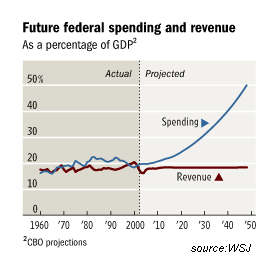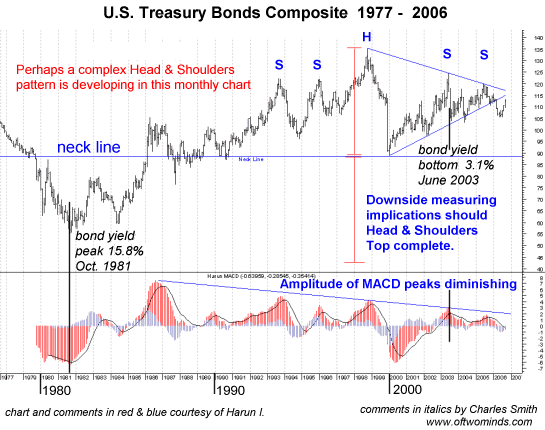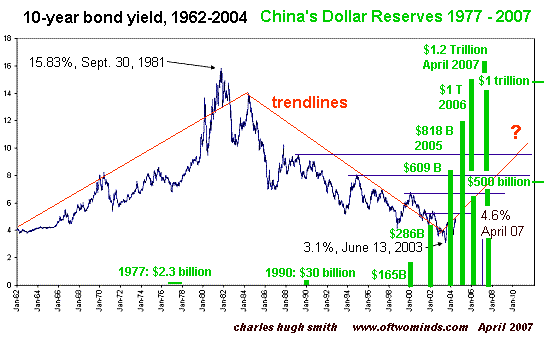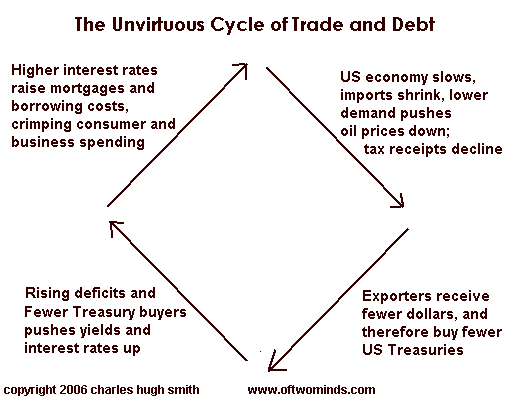Interest Rates and Supply and Demand
Astute reader Than H. recently posed this question:
"I know you have done a number of pieces on interest rate cuts, but it's sort of overwhelming to understand the complexities, so is there a quick correlation you can tell me about or would you just recommend I read your posts on the subject? I understand that in a sense, cuts are good for Wall Street short-term, but bad for the U.S. (and Dollar strength) long-term, and I don't quite grasp why."
Despite the many complexities Than alludes to--for instance, currency carry trades-- I think we can achieve some basic clarity by looking at credit as a commodity, i.e. in terms of supply and demand.
So first, let's understand that the Fed Funds Rate which the Fed had dropped 3% in the past few months is the rate charged to banks, not consumers. While there is a correlation between the Fed lowering rates and the cost of credit to various financial players, it is virtually nonexistent in terms of consumer credit.
The reason is that in a credit crunch, lenders are (suddenly) wary of risk, and their ability to insure themselves against loss either disappears or rapidly increases in cost. As a result, auto loan and mortgage rates have not dropped 3% in the past few months; they have actually increased. (Needless to say, credit card interest rates haven't dropped 3% either.)
Until recently, lenders could bundle their consumer and commercial loans and mortgages and sell them to institutions around the world. This increased the velocity and volume of credit. If you wrote $100 million in new home mortgages, you could quickly offload those loans to an investment bank who would bundle and sell them as mortgage-backed securities. This cleared your loan book and you could then sell another $100 million in new mortgages.
The demand for debt was thus high, and so the supply could increase by leaps and bounds. Credit was easy, and debt was easily sold.
Now that risk is being recognized and re-priced, institutions are wary about buying new debt whose risk is essentially opaque. That is, recently they trusted AAA rated debt and they lost huge sums of money as that debt lost value. So now they are restrained from buying more potentially risky debt.
The demand for new debt has dried up, and so the supply of credit is drying up, too. If there are no buyers for new debt, then the lenders have to keep whatever loans they write on their own books. That reduces how much credit they can extend, regardless of the qualifications of the borrower.
Put another way: as risk is recognized as opaque/unknown and trust vanishes, de
mand for new debt drops. The supply of credit is thus restricted, and an imbalance is created between supply of credit (tight) and demand for credit (high). As with any commodity, tight supply and high demand leads to higher prices.
Consider the point of view of the lender: I can borrow from the Fed at low rates, which is nice, but where can I extend new credit without risking losses? Housing? You've got to be kidding. Consumer credit and auto loans as the country slides into recession? Forget it. Now that pension funds, insurance companies and non-U.S. institutions are suffering stupendous losses on the U.S. debt they purchased in the past, then I can't sell new debt. That tunnel is now a pinhole.
In other words, the supply of actual available credit has shrunk, regardless of what the Fed does with its Fed Funds Rate and Discount Window. That means the cost of credit is rising.
Let's look at some charts. The first chart (above) shows that on the Federal level, the demand for credit/borrowing via selling Treasury bills is set to skyrocket as the cost of entitlements (Social Security and Medicare) are poised to ramp up dramatically for decades to come. With the U.S. government already in deficit, this massive demand will drive up the cost of money: it's simple supply and demand. As credit supply tightens and demand soars, prices rise--perhaps by a lot.
From the technical point of view, we see in the next chart courtesy of frequent contributor Harun I.) that the interest rates on U.S. bonds appears poised to increase. (Recall that bond yields and face value are inversely correlated; as interest rates rise, the face value of existing bonds drops; as interest rates drop, the face value of existing bonds rises.)
Here we see how bond yields (interest paid) runs in cycles of about 20+ years. We also see how interest rates could stay low even as the U.S. borrows ever more prodigious sums: China and other nations have, via their central banks, bought astounding quantities of U.S. bonds. The high demand (deficit spending) has been met with equally high supply (of buyers willing to snap up U.S. bonds for a pathetically low rate of interest/yield).
But now this virtuous cycle has reversed. As the dollar plummets (again, for reasons of supply and demand), central banks are unloading their U.S. debt and cutting back their new purchases. The demand for new U.S. debt is dropping--precipitiously for mortgages and commercial debt, and more slowly for long-term Federal debt.
As demand for credit increases (due to deficit spending and a consumer economy), and supply decreases (nobody is dumb enough to keep buying U.S. mortgages), then the price of credit rises.
If you look at these charts, it seems highly likely that the cost of credit (the interest rate needed to pursuade someone to buy the debt) will rise for the next 15-20 years.
What are the consequences of such a cycle? No mystery there: a staggering rise in the cost of servicing the Federal debt and the consequent restraining of Federal spending, and the constriction of consumer debt and thus spending.
Some smart analysts are calling for an 18-month recession. Based on the charts and the simple laws of supply and demand, I suggest looking for an 18-year recession.
NOTE: contributions are humbly acknowledged in the order received. Your name and email remain confidential and will not be given to any other individual, company or agency.
Thank you, Richard M. ($20), for your generous contribution to this humble site. I am greatly honored by your support and readership. All contributors are listed below in acknowledgement of my gratitude.
Friday, March 28, 2008
Terms of Service
All content on this blog is provided by Trewe LLC for informational purposes only. The owner of this blog makes no representations as to the accuracy or completeness of any information on this site or found by following any link on this site. The owner will not be liable for any errors or omissions in this information nor for the availability of this information. The owner will not be liable for any losses, injuries, or damages from the display or use of this information. These terms and conditions of use are subject to change at anytime and without notice.
Our Privacy Policy:
Correspondents' email is strictly confidential. This site does not collect digital data from visitors or distribute cookies. Advertisements served by a third-party advertising network (Investing Channel) may use cookies or collect information from visitors for the purpose of Interest-Based Advertising; if you wish to opt out of Interest-Based Advertising, please go to Opt out of interest-based advertising (The Network Advertising Initiative). If you have other privacy concerns relating to advertisements, please contact advertisers directly. Websites and blog links on the site's blog roll are posted at my discretion.
PRIVACY NOTICE FOR EEA INDIVIDUALS
This section covers disclosures on the General Data Protection Regulation (GDPR) for users residing within EEA only. GDPR replaces the existing Directive 95/46/ec, and aims at harmonizing data protection laws in the EU that are fit for purpose in the digital age. The primary objective of the GDPR is to give citizens back control of their personal data. Please follow the link below to access InvestingChannel’s General Data Protection Notice. https://stg.media.investingchannel.com/gdpr-notice/
Notice of Compliance with
The California Consumer Protection Act
This site does not collect digital data from visitors or distribute cookies.
Advertisements served by a third-party advertising network
(Investing Channel) may use cookies or collect information from visitors for the
purpose of Interest-Based Advertising. If you do not want any personal information
that may be collected by third-party advertising to be sold, please
follow the instructions on this page:
Limit the Use of My Sensitive Personal Information.
Regarding Cookies:
This site does not collect digital data from visitors or distribute cookies. Advertisements served by third-party advertising networks such as Investing Channel may use cookies or collect information from visitors for the purpose of Interest-Based Advertising; if you wish to opt out of Interest-Based Advertising, please go to Opt out of interest-based advertising (The Network Advertising Initiative) If you have other privacy concerns relating to advertisements, please contact advertisers directly.
Our Commission Policy:
As an Amazon Associate I earn from qualifying purchases. I also earn a commission on purchases of precious metals via BullionVault. I receive no fees or compensation for any other non-advertising links or content posted on my site.
























